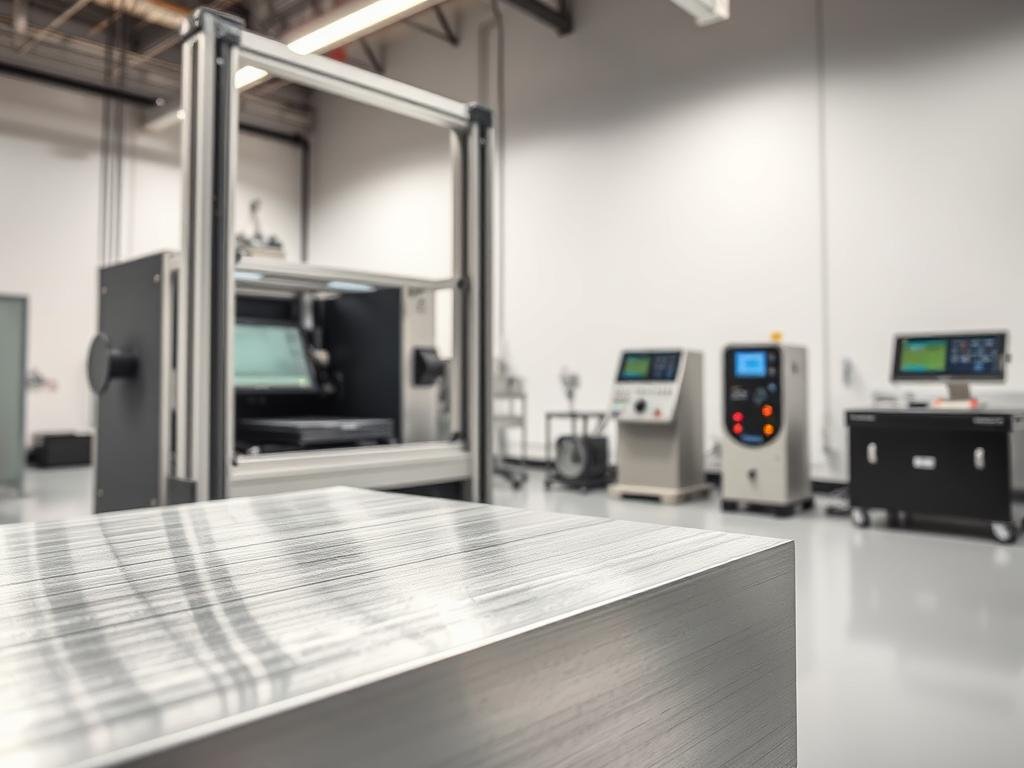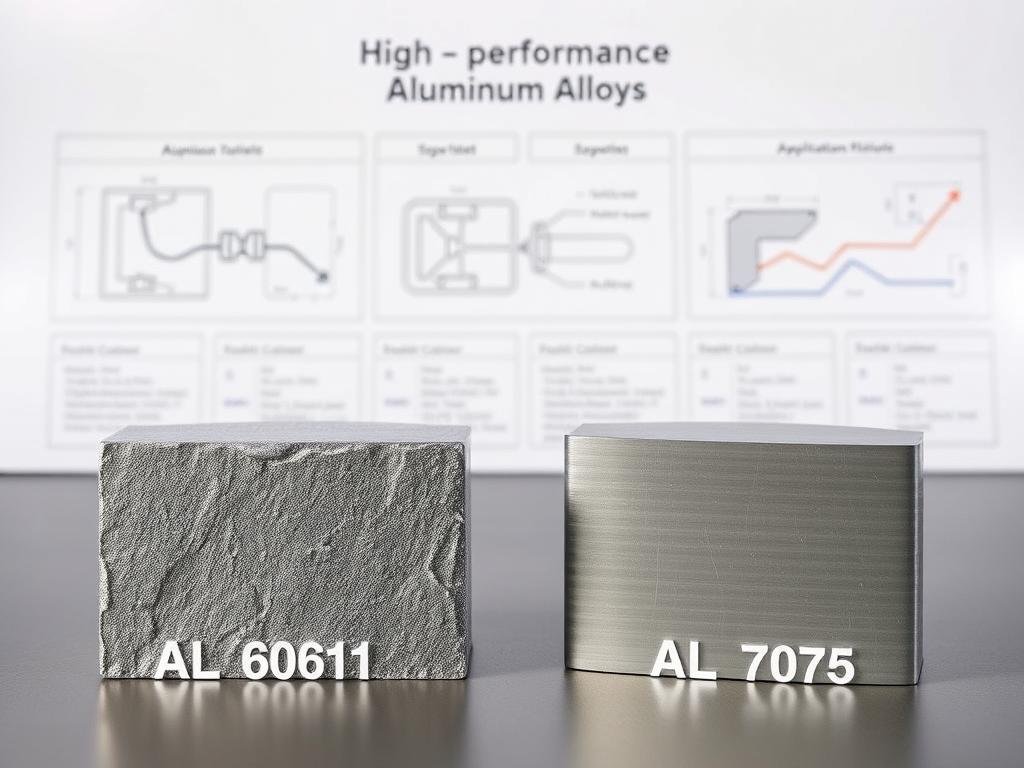The aluminum alloy 6061 is widely recognized for its exceptional mechanical properties and is a popular choice in the aerospace and CNC machining industries.
Understanding the density of this metal is crucial for engineers and manufacturers who require a high strength-to-weight ratio in their applications.
With a density of 2.7 g/cm³, 6061 aluminum offers an ideal balance between weight and mechanical properties, making it suitable for weight-critical applications.
The unique combination of aluminum and its alloy elements provides the necessary strength and durability, while maintaining a relatively low weight.
Understanding AL 6061 Aluminum Alloy
The 6061 aluminum alloy stands out for its unique combination of strength, corrosion resistance, and weldability, making it a versatile material for various applications.
Origin and Development of 6061 Aluminum
6061 aluminum alloy was first developed in the early 20th century as part of the 6xxx series, which utilizes magnesium and silicon as primary alloying elements. As noted by industry experts, “The development of 6061 aluminum marked a significant milestone in the production of high-strength, corrosion-resistant aluminum alloys.”
Chemical Composition and Alloying Elements
The chemical composition of 6061 aluminum includes magnesium and silicon as its main alloying elements, which contribute to its strength and corrosion resistance. The presence of these elements allows 6061 aluminum to achieve a balance between mechanical properties and formability.
The 6xxx Series Classification
The 6xxx series classification is defined by the use of magnesium and silicon as primary alloying elements. This series is known for its excellent formability, weldability, and good corrosion resistance compared to other aluminum alloy series. As a result, 6061 has become one of the most widely used alloys within this series, suitable for a wide range of applications.
In conclusion, understanding the characteristics of 6061 aluminum alloy is essential for leveraging its properties in various industries.
AL 6061 Density and Physical Properties
Density is a vital specification for AL6061 aluminum, affecting its use in complex applications where multiple physical properties are considered.

Density Measurement and Significance
The density of AL6061 aluminum is typically measured using standardized methods, providing crucial data for engineers to assess its suitability for various applications.
This measurement is significant as it influences the material’s overall performance, including its strength, conductivity, and thermal properties.
Temperature Effects on Density
Temperature variations can affect the density of AL6061 aluminum, with changes in temperature leading to expansion or contraction of the material.
Understanding these effects is crucial for applications where AL6061 is exposed to extreme temperatures, such as in aerospace or high-temperature processing equipment.
Relationship Between Density and Other Physical Properties
The density of AL6061 aluminum is interconnected with its other physical properties, including thermal conductivity, electrical conductivity, and specific heat capacity.
For instance, AL6061’s excellent thermal conductivity (167 W/m-K) makes it suitable for heat sink applications and thermal management systems.
- The density of AL6061 relates to its excellent thermal conductivity, making it suitable for heat sink applications.
- The relatively low density of AL6061 doesn’t compromise its good electrical conductivity (43% IACS).
- Density correlates with acoustic properties and vibration damping characteristics, important in applications like musical instruments.
Understanding these interrelationships helps engineers make informed material selections when balancing multiple performance requirements.
Mechanical Properties of 6061 Aluminum
The mechanical properties of 6061 aluminum, including strength and elasticity, play a significant role in its widespread adoption. These properties are critical in determining the alloy’s suitability for various applications, particularly in the aerospace and CNC machining industries.
Tensile and Yield Strength
The tensile strength of 6061-T6 aluminum is a key factor in its selection for structural components. With a typical ultimate tensile strength of 310 MPa (45 ksi) and a yield strength of 276 MPa (40 ksi), this alloy offers a good balance between strength and formability. The high yield strength is particularly important in applications where dimensional stability under load is crucial.
Hardness and Machinability
6061 aluminum is known for its excellent machinability, which is attributed to its chemical composition and the presence of certain alloying elements. The hardness of 6061-T6, typically in the range of 95-100 HB, contributes to its wear resistance while maintaining good machinability characteristics. This combination makes it an ideal material for precision-machined parts.

Fatigue Resistance and Elasticity
6061-T6 aluminum has a fatigue resistance limit of 95 MPa (14 ksi), which is an important consideration for components subjected to cyclic loading. The modulus of elasticity, at 69 GPa (10 million psi), indicates a relatively low stiffness compared to steel, affecting deflection and design considerations. The elastic properties of 6061 aluminum also influence its vibration characteristics and dimensional stability under load.
The relationship between fatigue resistance and surface treatments or finishing operations is also significant. Various surface treatments can enhance the fatigue properties of 6061 components, making it a versatile material for safety-critical applications.
Temper Designations and Their Impact
Temper designations play a vital role in determining the performance of 6061 aluminum alloys. The temper designation indicates the specific heat treatment process applied to the material, which significantly affects its mechanical properties.
6061-T6 vs. 6061-O Properties
The 6061-T6 temper is achieved through a specific heat treatment process, resulting in high strength and good corrosion resistance. In contrast, 6061-O is annealed, offering improved formability but lower strength. The table below highlights the key differences between these two tempers.
| Property | 6061-T6 | 6061-O |
|---|---|---|
| Tensile Strength (MPa) | 310 | 150 |
| Yield Strength (MPa) | 275 | 55 |
| Elongation at Break (%) | 12 | 25 |
Heat Treatment Effects on Material Properties
Heat treatment is a critical process for achieving desired properties in 6061 aluminum. The material is solution heat-treated at approximately 530°C (985°F), followed by artificial aging at 160-175°C (320-345°F) for 8-18 hours to achieve T6 properties. This process enhances the material’s strength by promoting the precipitation of magnesium silicide (Mg2Si) particles.
The controlled precipitation of Mg2Si particles creates obstacles to dislocation movement, thereby increasing the alloy’s strength. Variations in heat treatment parameters can produce different temper designations with corresponding changes in mechanical properties.
Comparing AL 6061 vs. 7075 Aluminum
The choice between AL6061 and 7075 aluminum alloys depends on several factors, including density, strength, and cost considerations. Both alloys are widely used in various industries, but they have distinct properties that make them suitable for different applications.
Density and Weight Differences
AL6061 and 7075 aluminum alloys have densities of approximately 2.7 g/cm³ and 2.8 g/cm³, respectively. Although their densities are similar, the difference in composition affects their weight and application in engineering projects. The slightly higher density of 7075 is due to its higher zinc content.

Strength-to-Weight Ratio Comparison
A significant difference between AL6061-T6 and 7075-T6 lies in their tensile strength. 7075-T6 has a tensile strength of 503 MPa (73,000 psi), compared to 310 MPa (45,000 psi) for 6061-T6. Moreover, the shear strength of 7075-T6 is estimated to be 1.5 times that of 6061-T6, making 7075 more suitable for high-stress applications.
Cost and Availability Factors
The cost difference between 6061 and 7075 aluminum alloys is significant, with 6061 being typically 30-50% less expensive. This is due to the more common alloying elements in 6061 and its higher production volumes. Additionally, 6061 is more widely available in various forms (sheet, plate, bar, extrusions) and from more suppliers than 7075. The availability and cost factors significantly impact material selection decisions, especially in high-volume production where material costs are a crucial factor.
Supply chain considerations, including lead times and minimum order quantities, also influence the choice between these alloys. The superior corrosion resistance of 6061 may result in lower lifecycle costs, particularly in corrosive environments, despite 7075’s higher strength.
AL 6061 vs. 6063: Density and Application Differences
In the realm of aluminum alloys, AL6061 and 6063 stand out for their unique characteristics, making the choice between them dependent on specific application requirements. While both are part of the 6xxx series, known for their weldability and corrosion resistance, they differ in composition, density, and formability.
Composition and Density Variations
AL6061 and 6063 aluminum alloys have different compositions that affect their density and application suitability. AL6061 contains a higher percentage of magnesium and silicon, contributing to its higher strength. The density of both alloys is approximately 2.7 g/cm³, making them similar in this aspect. However, their differing compositions influence their mechanical properties and corrosion resistance.
| Alloy | Density (g/cm³) | Major Alloying Elements |
|---|---|---|
| 6061 | 2.7 | Magnesium, Silicon |
| 6063 | 2.7 | Silicon, Magnesium |
Extrusion and Formability Comparison
6063 aluminum is renowned for its excellent extrusion capabilities and formability, making it a top choice for architectural applications where complex shapes are required. In contrast, AL6061, while still formable, is more commonly used in applications requiring higher strength and better machinability.
Selecting Between 6061 and 6063 for Specific Applications
The selection between AL6061 and 6063 depends on the specific requirements of the application. For structural applications and situations where higher strength is necessary, AL6061 is typically preferred. For architectural applications, complex extrusions, and where a superior surface finish is desired, 6063 is often the better choice. Factors such as anodizing response, corrosion resistance, and aesthetic considerations also play a crucial role in this selection process.
Critical Applications Leveraging AL 6061 Density
The density of AL6061 aluminum plays a crucial role in its widespread adoption across various industries. Its unique combination of low density, good strength, and excellent corrosion resistance makes it an ideal material for numerous critical applications.
Aerospace and Aircraft Components
In the aerospace industry, AL6061 aluminum is used for aircraft components due to its favorable strength-to-weight ratio. The alloy’s density contributes to fuel efficiency and payload capacity, making it a preferred choice for aircraft parts.
CNC Machining Considerations
When it comes to CNC machining, the density of 6061 aluminum allows for efficient processing and precision. The material’s machinability is enhanced by its density, which enables the production of complex parts with high accuracy.
Marine and Transportation Applications
The marine industry utilizes 6061 aluminum alloy for shipbuilding, including sailboats, yachts, and marine hardware, due to its resistance to saltwater corrosion and low density. In transportation, 6061 aluminum is used in automotive components, truck bodies, railway cars, and mass transit vehicles, contributing to fuel efficiency and payload capacity.
| Industry | Applications | Benefits of AL6061 Density |
|---|---|---|
| Aerospace | Aircraft components | Fuel efficiency, payload capacity |
| Marine | Shipbuilding, marine hardware | Corrosion resistance, light weight |
| Transportation | Automotive components, truck bodies, railway cars | Fuel efficiency, payload capacity, structural integrity |
The use of 6061 aluminum alloy in these applications not only enhances performance but also provides economic and environmental benefits, including fuel savings, emissions reductions, and lifecycle advantages due to the material’s recyclability and durability.
Conclusion: Making Informed Material Selections Based on Density Requirements
Ultimately, understanding the density of AL6061 aluminum is essential for making informed decisions in material selection. The density of this alloy, combined with its other properties, such as strength and machinability, makes it a popular choice for various applications.
When selecting a material, engineers and designers must consider the complete property profile, including density, to ensure that the chosen material meets all relevant performance requirements and economic factors. Comparing AL6061 to other alloys like 7075 and 6063 can help determine the optimal choice based on the specific application’s needs.
Future trends in aluminum alloy development are focused on creating materials with even better density-to-strength ratios through advanced metallurgical techniques. By considering these factors and understanding the properties of different alloys, professionals can make more informed material selections.
